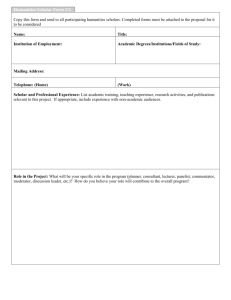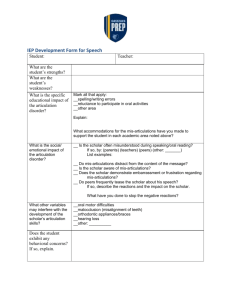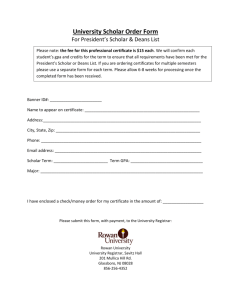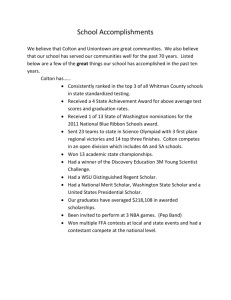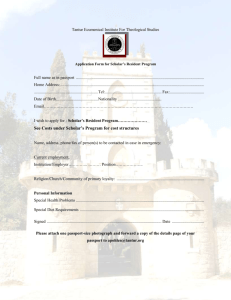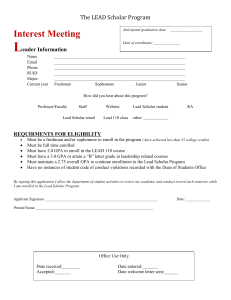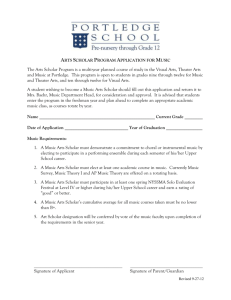Math and Science Night October 20, 2010 2nd Grade Activity
advertisement
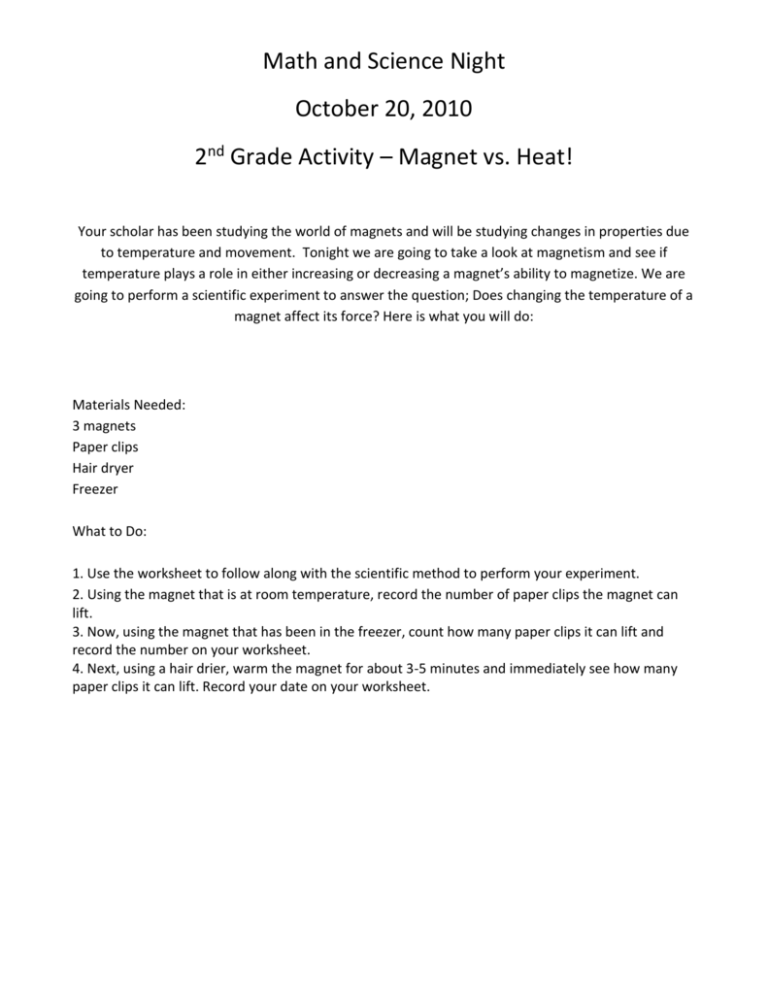
Math and Science Night October 20, 2010 2nd Grade Activity – Magnet vs. Heat! Your scholar has been studying the world of magnets and will be studying changes in properties due to temperature and movement. Tonight we are going to take a look at magnetism and see if temperature plays a role in either increasing or decreasing a magnet’s ability to magnetize. We are going to perform a scientific experiment to answer the question; Does changing the temperature of a magnet affect its force? Here is what you will do: Materials Needed: 3 magnets Paper clips Hair dryer Freezer What to Do: 1. Use the worksheet to follow along with the scientific method to perform your experiment. 2. Using the magnet that is at room temperature, record the number of paper clips the magnet can lift. 3. Now, using the magnet that has been in the freezer, count how many paper clips it can lift and record the number on your worksheet. 4. Next, using a hair drier, warm the magnet for about 3-5 minutes and immediately see how many paper clips it can lift. Record your date on your worksheet. Magnets vs. Heat Question: Does temperature affect the force of a magnet? Hypothesis: Temperature DOES / DOES NOT affect the force of a magnet. (This is your chance to decide whether you think the temperature change will affect the magnet’s force. If you think it will change the amount of force, circle “DOES”, if you don’t, circle “DOES NOT” This is an educated guess!) Method: 1. Using the magnet that is at room temperature, record the number of paper clips the magnet can lift. 2. Now, using the magnet that has been in the freezer, count how many paper clips it can lift and record the number on your worksheet. 3. Next, using a hair drier, warm the magnet for about 3-5 minutes and immediately see how many paper clips it can lift. Record your date on your worksheet. Results: Temperature of Magnet Number of Paper Clips Room Temperature Cold Hot Conclusion: (Did your results support your hypothesis? What could you try to do differently next time to improve the experiment and your results?) ___________________________________________________________________________________ ___________________________________________________________________________________ ___________________________________________________________________________________ ___________________________________________________________________________________ ___________________________________________________________________________________ ___________________________________________________________________________________ Math and Science Night at Laureate Preparatory October 20th, 2010 2nd Grade This packet contains activities that you can do at home with your scholar. Most of the supplies that are needed can be found around your home or neighborhood. It is always a great idea, if more information is needed about a certain topic, to turn to the internet or your local library and you and your scholar can look up the additional information together. Showing your scholar the different ways they can explore their world is a great asset for them to have. The second grade classes are learning about the scientific method, classifying matter, and soon they will begin studying about the natural world that surrounds them on a daily basis. The following are a few suggestions for activities that can be done at home that will complement what your scholar is learning at school. Always feel free to add any further activities that you have in mind to enhance your scholar’s learning! While you are going through these activities with your scholar, keep in mind what it means to be a scientist and how you can apply inquiry based thinking to each of these activities. Help your scholar think of why these things are happening, how they can improve on them, what they could try differently next time, and where these topics can be applied in everyday life. Asking your scholar questions throughout the activities will lead them to be thinking more and more about these topics, which in turn, will help them learn more when they are in classroom. Background Information Properties of Matter: Everything around us is made up of molecules. Some matter is hard and we call it a solid, while other matter takes the shape of the container it is in and we call it a liquid and lastly some matter is in the air and all around us and we call it gas. The three different states of matter are solid, liquid, and gas. With each state, the molecules become more and more spread apart allowing the substance to change from a solid (in which the molecules are tightly packed together), to a liquid (in which the molecules are heated up and can spread out more), to a gas (in which the molecules are bouncing off one another and moving around even more). These states of matter are one concept your scholar is learning about and how they can change or manipulate them into something else. Scientific Method: There are seven steps your scholar can follow to design and plan an experiment. State the Problem: What do you want to find out? Look at your problem and express it as a question. Be sure to make the problem as specific as possible. Hypothesize: What do you think is the cause of your problem? Develop a logical answer to your problem; this will become your hypothesis. Your answer should include one explanation for the cause to your problem. Plan Your Experiment: The goal of any experiment is to test a hypothesis. Determine your variable and control; then write a clear step-by-step procedure so that anyone can repeat the process of the experiment. Make a Prediction: Using your hypothesis, make and record a prediction about the outcome of your experiment. Gather and Organize Data: Determine what kinds of data you will collect. Will it be measurements, observations, or estimates? Will you use tables, graphs, or drawings to organize this data? Analyze Data: Once you have collected your data, determine if you see any trends or patterns. Does the data support your hypothesis? Do you still need to collect additional information? Conclude: Use your data to state your conclusion. Your data should either support your conclusion or lead you to another hypothesis. Have any new questions or problems developed? Some problems you and your scholar can experiment with together: Does the color of food or drinks affect whether or not we like them? Which kinds of food do dogs (or any animal) prefer best? Which paper towel brand is the strongest? What is the best way to keep an ice cube from melting? What is the best way to keep cut flowers fresh the longest? Does the color of light used on plants affect how well they grow? What brand of battery lasts the longest? What type of food allow mold to grow the fastest? Does the color of hair affect how much static electricity it can carry? (test with balloons) What brands of bubble gum produce the biggest bubbles? An excellent website to find more ideas for experiments that you can do at home is: http://www.sciencebob.com/experiments/index.php Classifying Matter: States of Matter House: Walk with your scholar around your home and find objects that are solids, liquids, and gases. Solids can include furniture and clothing, liquids can include condiments and juices in your refrigerator, and gases can include aerosol cans such as hair sprays and air fresheners. Encourage your scholar to describe the properties of each kind of matter and write down his or her observations in a notebook. Liquid Lunch: Together examine the properties of different liquids in your home and compare and contrast them. You can investigate liquids such as water, heavy cream, juice, glue, rubber cement, etc. Which liquids are thick? Which are thin? Which spread quickly on a surface? Which are clear? Which liquids are harmful (toxic) and which are healthy? Which things look solid, but can be turned into liquids? Encourage your scholar to write his or her observations and ideas in a Venn diagram, compare-and-contrast chart, or other graphic organizer. As an extension, remind your scholar that liquids take the shape of their containers. Experiment pouring liquids into containers of different shapes and sizes, then have your scholar pour the same amount of liquid into each container. How do the shapes change? Why do some containers appear to have more liquid than others? Mass Mania: Review with your scholar that mass is the amount of matter in an object. Explain that some objects may seem very large but have little mass. For example, a balloon is bigger than a key, but the balloon has less mass. A foot of yarn is longer than a marble, but the marble has more mass. Brainstorm different examples. Conservation: One Hundred Ways: Cut down on waste using reusable item. Together find an item in your home that you can reuse instead of throwing it away. Then brainstorm ways you can reuse the items. For example, a chipped cup can be used as a container for pens and pencils, a flower pot, a mixing receptacle for paint, a rain gauge, etc. Encourage your scholar to be creative! Remake: Millions of unwanted or broken toys end up in our landfills each year. Have your scholar reduce waste by repurposing or fixing an old toy. He or she may want to take a toy apart and make a new toy or fix a favorite broken plaything. This can be a fun art project, so encourage your scholar to be creative. You may want to provide non-toxic paints or glue to help your scholar make his or her creations. What Comes from Trees? Challenge your scholar to figure out what comes from trees. The answers will startle them! Encourage them to do research on the Internet or at the library to learn different ways we use trees, an important natural resource. Trees provide us with many things, including fresh air, so it's important to conserve them.

